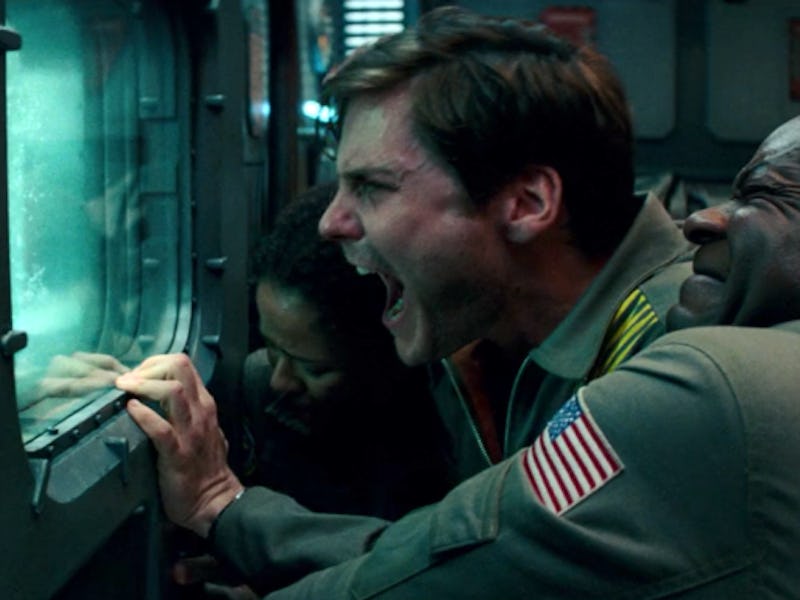'Cloverfield Paradox' Mashes Up Every Space Horror, and Reviews Are Mixed
Reactions to Netflix's surprise release are in.

One of the biggest surprises from Super Bowl 52 was not the Eagles’ first-ever championship win, but Netflix dropping a trailer for The Cloverfield Paradox along with the news that it’d be streaming right after the game. That’s right, Netflix pulled a Beyonce with its latest feature-length film.
Tons of people have watched the follow-up to Cloverfield and 12 Cloverfield Lane in the last 12 hours. Most people seem moderately frustrated by what amounts to a derivative bit of space-based horror that raises more questions about Cloverfield than it answers. Reviews are decidedly mixed, with most people bewildered about everything from the surprise release to the film’s puzzling climax.
Spoilers follow for The Cloverfield Paradox.
The emotional core of the film is a communications officer named Hamilton (Gugu Mbatha-Raw), who goes on a long-term mission to an orbital space station rather than remain on a future version of an Earth running out of energy and other resources. Aboard Cloverfield Station, she and the rest of the team struggle to perfect the Shepard particle accelerator, which could create endless renewable energy forever, rip open interdimensional portals in space-time, or both. Who knows!
Hamilton lost her children in a fire, and in a lot of ways she's running away from her own past.
Writing for SlashFilm, Chris Evangelista argued that The Cloverfield Paradox tried and failed to be two movies at the same time.
On one hand, The Cloverfield Paradox feels like a cautionary tale about energy consumption and overpopulation and how both could lead to global war. On the other, it explores some hard sci-fi concepts that lead to an amalgamation of almost every space-horror scene you’ve watched in the last decade. Inexplicably, it all ties in somehow to that 2008 found-footage movie where a giant monster beheads the Statue of Liberty and people gawk at it, taking photos with their phones before fleeing for their lives.
Evangelista argues that a genuinely compelling movie is ultimately obscured by universe-building and a rushed plot:
“The Cloverfield Paradox is rushed to the extreme, sprinting towards a conclusion that ultimately feels like a huge middle finger to an audience that wants nothing more than to see this franchise succeed.”
The crew of 'Cloverfield Station'.
As such, the whole thing amounts to a “monstrous mess,” according to Benjamin Lee with The Guardain. “There are so many disparate elements carelessly smashed together by director Julius Onah,” Lee writes, “some of them genuinely intriguing yet most of them largely nonsensical, making it all feel like not just one but several scripts thrown into the same pot.”
The titular “Cloverfield Paradox” roughly correlates to some real-life theoretical physics that posits that particle accelerators can create ruptures in space-time. Some think the process could create black holes or even the Big Bang 2.0. Others, like the conspiracy theorists on the Earth of this film, think smashing atoms together in this way could create bridges to alternate realities. Donal Logue plays one of these crazies in a brief scene, arguing that the project might bring “demons” into the world. Yes, “demons.”
It comes off as weird and almost comical — like a zombie movie that actually uses “the ‘Z’ word” — especially considering the actual demons that do show up.
A giant monster plagues a city on Earth in 'The Cloverfield Paradox'.
A somewhat bored subplot follows Hamilton’s husband, Michael (Roger Davies), back on Earth trying to survive.
Right after the particle accelerator successfully fires and transports the crew and station to what we might as well call Earth-2, what looks like the original Cloverfield monster wreaks havoc on the city Michael lives in. He saves a little girl and winds up hiding out in a fallout bunker that looks an awful lot like the one from 10 Cloverfield Lane.
Jonathon Dornbush, writing for IGN, categorizes these sorts of scenes as suffocating fan service: “And the elements included to not only make it a Cloverfield film but seemingly the Dark Tower of this universe feel more like shoved-in fan service than details neatly woven into the fabric of the film.”
Sadly, this might have been a more interesting story without Michael constantly texting and calling some guy from NASA. Ultimately, the whole thing is a bit of a confusing mess that has a lot of heart — and even more space body horror.
Somebody lend this guy a hand.
In addition to all the stuff about monsters and dimension-hopping, the experiment also causes all manner of chaotic things to happen. Worms materialize inside the body of a crewmember, someone from an alternate dimension materializes inside the wall of the ship, and all sorts of trippy things almost kill everyone. And no, none of it really makes any sense.
For Forbes, Luke Y. Thompson draws an obvious connection between Lost’s storytelling and that of The Cloverfield Paradox, writing, “the plot doesn’t make much sense, but it’s really about the characters and their emotional journeys. Except this is a movie that can’t even make its mind up about that.” We even get the equivalent of the iconic “Not Penny’s Boat” scene in The Cloverfield Paradox, except it’s in space and rather than drown, the victim gets flash-frozen by a breach.
Ultimately, The Cloverfield Paradox perhaps tries to do too much, and far too little of it lands well. Tons of characters from the movie wind up dead, but chances are the Cloverfield franchise will survive long after this minor disaster.
The Cloverfield Paradox is now available to stream on Netflix.